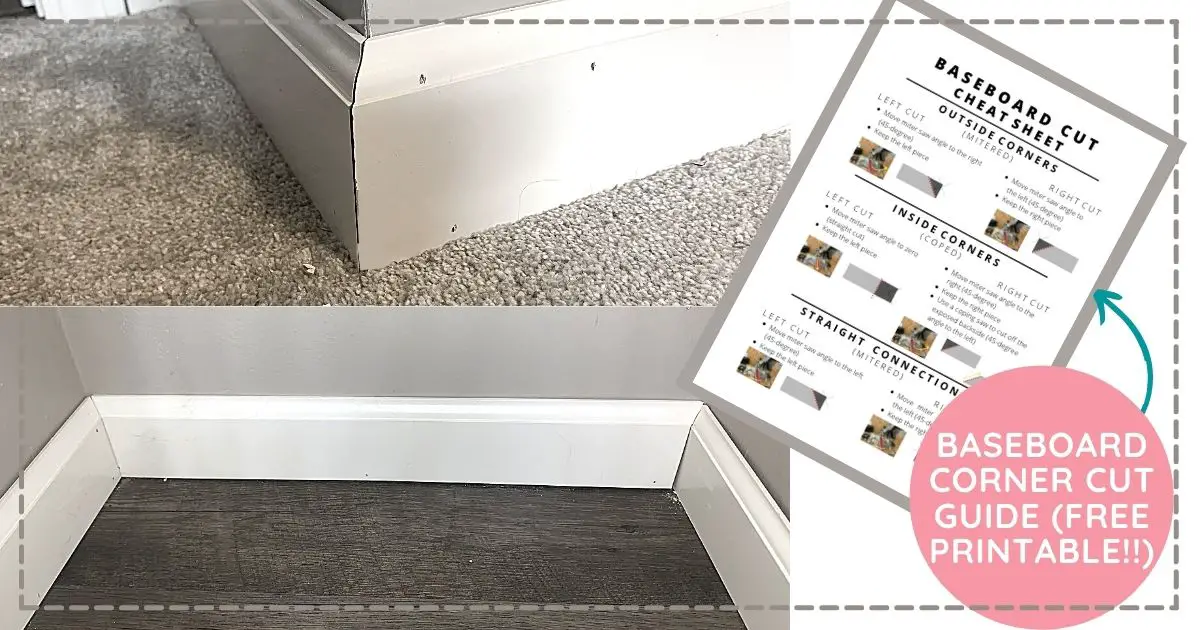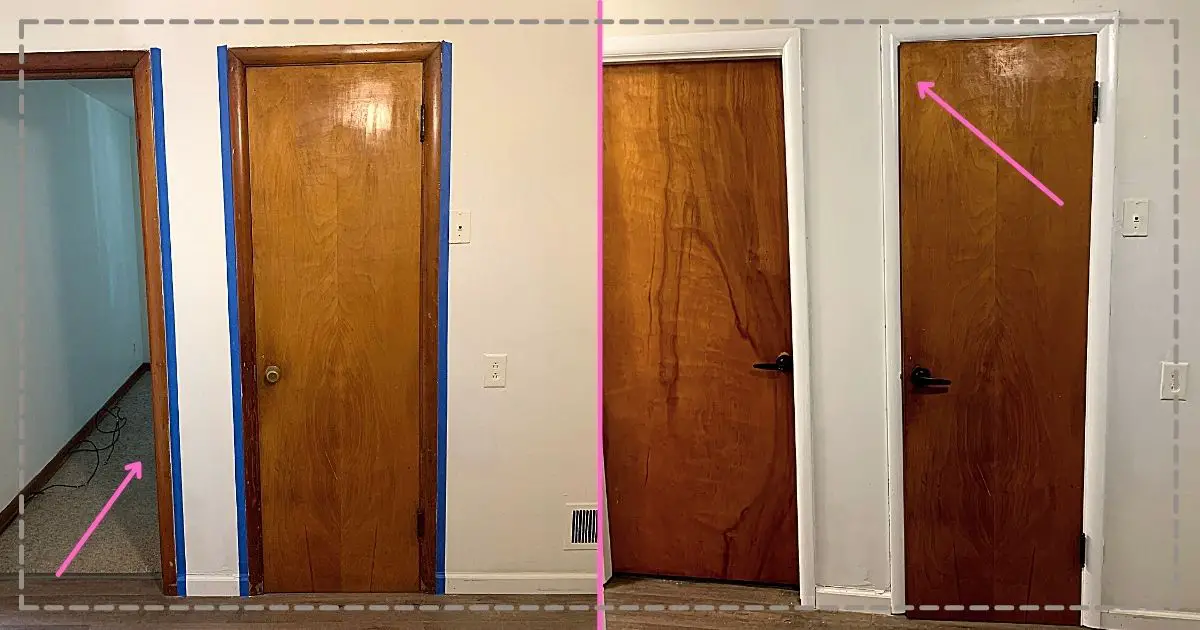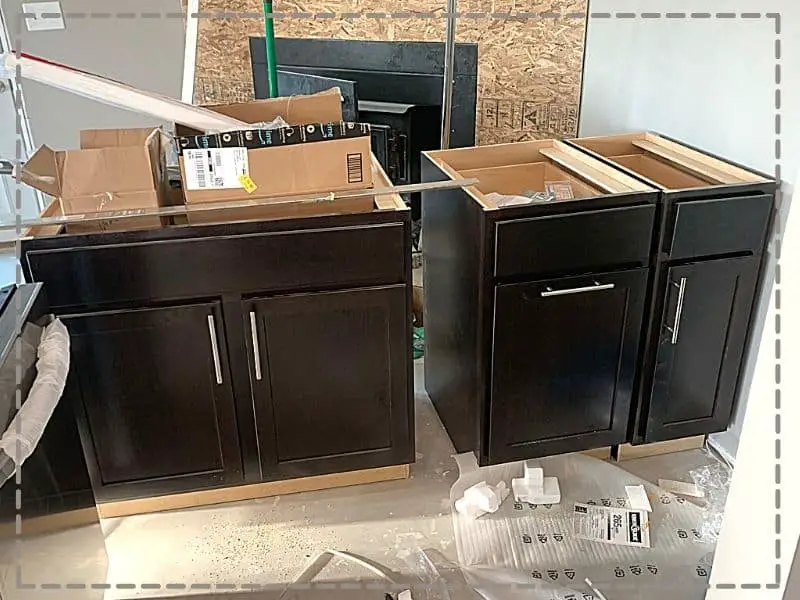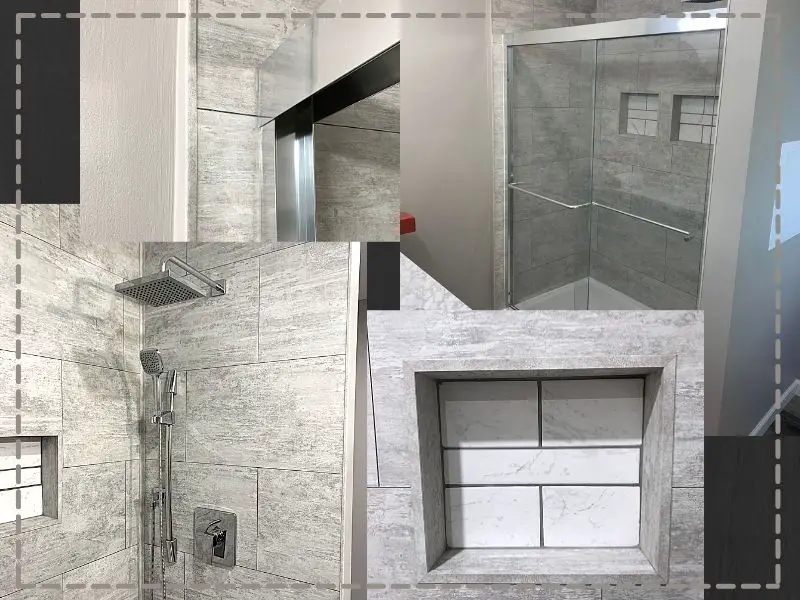*My posts may contain affiliate links, which means I may receive a small commission, at no cost to you, if you make a purchase through a link! Thank you for supporting my website!*
Last updated on September 11th, 2024 at 09:21 am
How To Add Custom Trim To Upgrade Your Kitchen Island
Are you installing a new kitchen island and trying to decide how to finish the back of your kitchen island? (Yes, I’m talking about covering that hideous seam between the two back panels! Who thought making such chintzy/cheap standard kitchen island back panels was a good idea?)
Then this tutorial is for you!
While we were renovating our house, we came across a problem when installing our new kitchen island. We bought standard paneling to cover the back of the cabinets that were exposed. We thought this would be a simple DIY project that wouldn’t take more than an hour to complete.
Ha! In the world of DIY and home improvement, nothing is ever simple or ever goes your way the first time. I know this, and yet, I still get my hopes up haha!
Unfortunately, both back panels came slightly damaged (on the factory edges that were supposed to create the seam, just our luck!). Honestly, even if they hadn’t been damaged on the edges, there was nothing that was going to hide the huge seam right in the middle!
Luckily, we thought quickly on our toes and came up with this super easy and super budget-friendly kitchen back panel idea that immediately solved our problem AND gave our kitchen island a complete upgrade!
I’d love to share with you what we did, so you can upgrade your kitchen island and make it look custom as well.
Let’s dive in!

Quick Navigation: How To Finish The Back Of Your Kitchen Island
- Measure each section that needs trim & cut (dry-fit as you go)
- Stain/paint the trim to match your cabinets
- Install with brad nails
- Final Thoughts
| Level Of Difficulty | Time To Complete |
|---|---|
| Easy | 2 Days |
| Material List | Tool List |
|---|---|
| Stain in your chosen color (I used Ebony from Varathane on this project because it matched our cabinets. On other projects, I’ve used Dark Walnut) | Miter saw or circular saw |
| Polyurethane in your chosen sheen (I used satin) | Pneumatic nail gun |
| 3 pieces of ¼” thick trim in preferred width and wood type (I used 3” pine trim ripped in half so each piece was a little under 1-½” wide) | Air compressor |
| 1 piece of ¼” thick corner trim in matching width and wood type (I used 1-1/16” x 1-1/16” pine corner trim) | Tape Measure |
| 1” brad nails | Mechanical Sander (optional) |
| Table saw (optional) | |
| Paint tray | |
| Two 2” Foam Brushes |
Step One: Measure Each Section That Needs Trim & Cut (Dry-Fit As You Go)
The first step we took to finish the back of our kitchen island was to measure and cut each trim piece.
For our island, we knew the very obvious seam right down the middle of the back panel, the open corners where the back panel met the cabinets, and where the back panel met the floor needed to be covered.
In addition, to make it look symmetrical and natural, I also wanted it along the top (under the countertop) and on the sides of the cabinets.
To accomplish this, we bought three 8 ft pieces of ¼” x 3” pine trim. We chose this because it was cheaper to rip the trim in half with our table saw, and the resulting size was very similar to the width of the corner trim and the lip on the cabinets.
So we ripped all 3 pieces of wood in half with our table saw. If you don’t have a table saw, then just buy the trim in the width you want it to be and save yourself a step.
After the boards were ripped, we took measurements and started cutting. We measured and cut in a specific order.
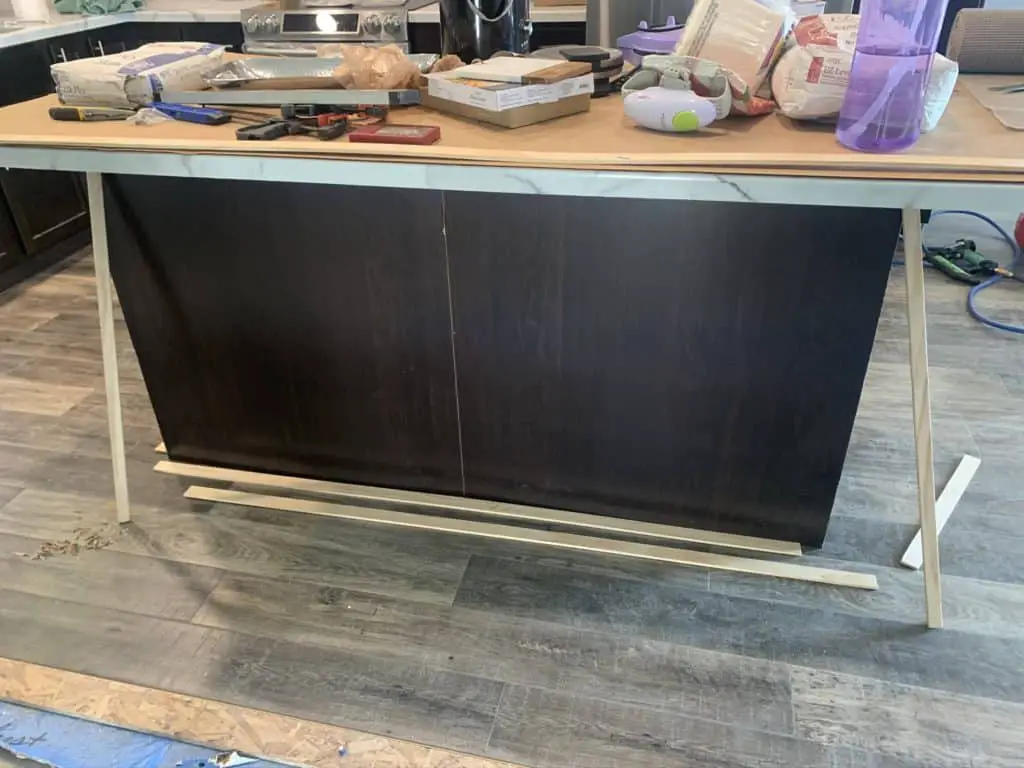
The Order We Measured and Cut
- Corners (using the corner trim – we covered all four corners: 2 on the backside of the cabinets and 2 baby ones on the front bottom of the cabinets)
- Top of the back of cabinets
- Bottom of the back of cabinets
- The seam in the middle back of cabinets
- Top of the right side of cabinets
- Bottom of the right side of cabinets
- Top of the left side of cabinets
- Bottom of the left side of cabinets
- Small connecting pieces on the sides of cabinets that connect the bottom trim to the existing lip on the side
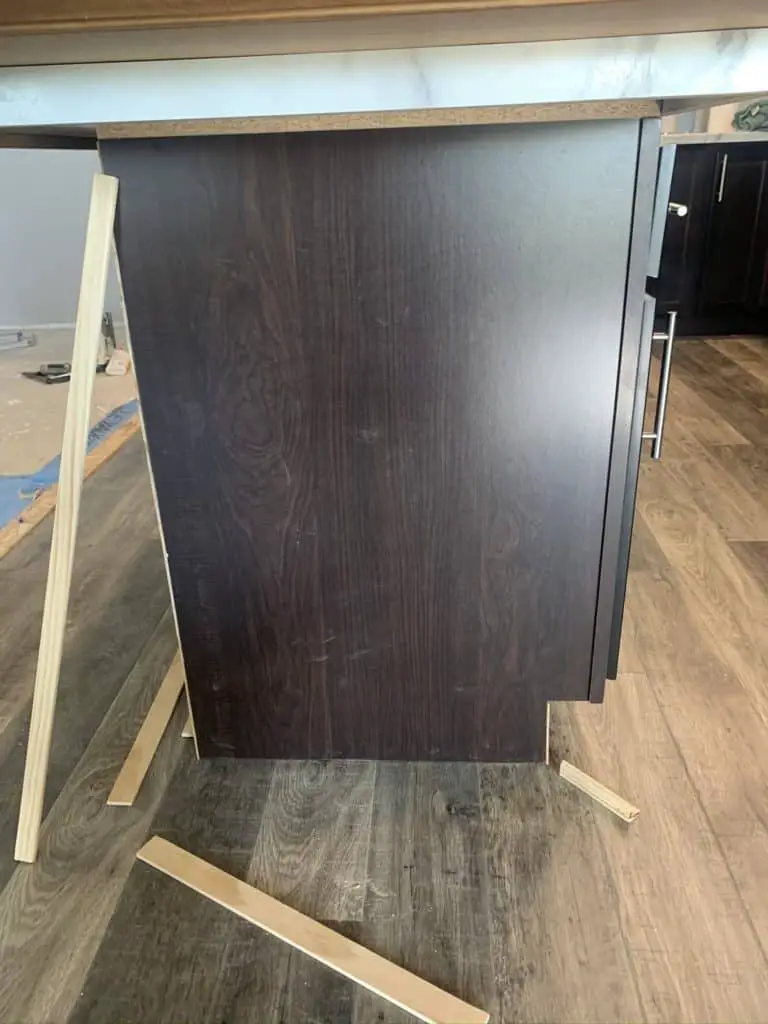

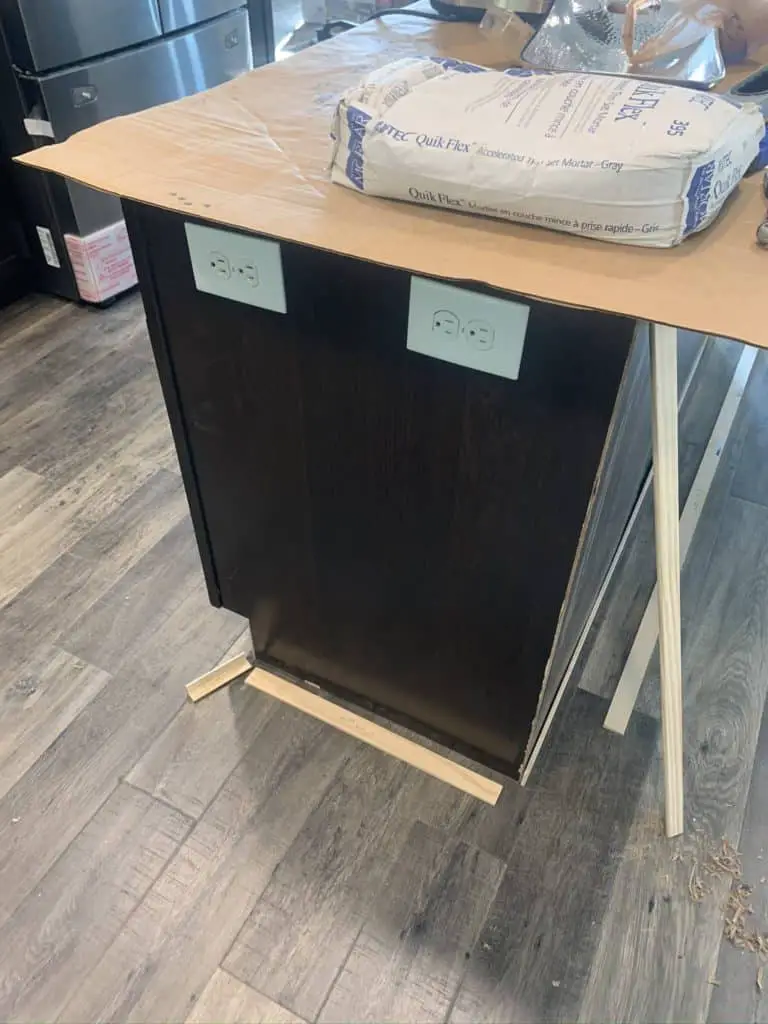
Be sure to cut and dry-fit the pieces as you go, so you know they’ll fit correctly when you go to install. And most importantly, don’t forget to label your pieces! It’ll make installing them so much easier later on!
Honestly, you could get super creative here and do any wood design you want! You could do a board and batten style look, or funky geometric shapes, or a simple trim like we did. Decide on your design and go with it! Anything will look better than a seam sticking out or just a plain old builder-grade design.
Step Two: Stain/Paint The Trim To Match Your Cabinets
The next step we took to finish the back of our kitchen island was to stain the trim to match our cabinets.
Once all of your pieces are cut and fit properly, it’s time to stain or paint! If you’re painting your trim, then you’re in luck. This project will go much quicker for you!
However, if you’re staining your trim to match your cabinets as we did, then it’s time to buckle down and get to work.
I recommend doing this part on some cardboard and sawhorses because it’s much easier to work while standing up than hunched over for an hour at a time (that’s how long it took me to apply each coat – an hour of straight brushing!)
Paint vs Stain
First, though, sand any edges that you cut to make sure there aren’t any splinters or rough patches. I’d also run the sandpaper over the rest of the trim that’ll be the “show parts” to make sure the paint or stain adheres really well.
Next, wipe all the pieces down, then break out your foam brush if you’re staining or your small foam roller if you’re painting. (Foam is the best for wood – it doesn’t leave yucky fuzzies in the paint or stain like other rollers will.)
Do the edges first, then brush or roll the face. If you’re painting, try to brush in one direction pulling the paint as far as possible before picking it up.
If you’re staining, swipe the stain on then immediately wipe it off with a clean rag. The longer the stain sits on the wood, the deeper the color. For my trim, it went on so dark, I had to wipe it off immediately to let the wood grains shine through still.
(We have dark (almost black) stained kitchen cabinets that I wanted to match, so we went with Ebony by Varathane.)
For paint, 3 coats should do. I recommend one coat of primer such as this Zinsser primer found at Amazon then 2 coats of Cabinet, Door, and Trim paint in your chosen color. If you use Cabinet, Door, and Trim paint, it’s meant to be glossy and durable, so an additional topcoat shouldn’t be necessary.
For stain, after the dry time listed on the can, apply 3 coats of polyurethane. I know, 3 coats seem like a lot, but your trim will appear foggy until you apply the 3rd coat. Take the time to do it now, so you can have a beautifully trimmed island for years to come!
For either application, if at any point, there are bubbles or unevenness, then sand out the blemish and apply another coat. You’ll be having a smooth, professional finish on your trim in no time!
Paint vs Stain Application
Here’s a quick reference of everything we just discussed, laid out in an easy-to-read table format for you!
| Category | For Stain | For Paint |
|---|---|---|
| Type of brush | Foam brush | Foam roller |
| Application | Brush the edges and face, then immediately wipe it off with a clean rag (let sit if a darker color is preferred) | Roll the edges, then roll the face |
| # of coats | 1 coat of stain, 3 coats of polyurethane | 3 coats |
| Topcoat | Yes, 3 coats minimum | Optional |
Step Three: Install With Brad Nails
The last step we took to finish the back of our kitchen island was to install all the finished trim pieces with brad nails.
Once your trim is completely dry, it’s time to install! Take your labeled pieces and start installing them in the same order you cut them.
Hold the piece up, brad nail it into place, and move on to the next one. Keep going until you run out of pieces, then step back and admire your handiwork because you did it!!
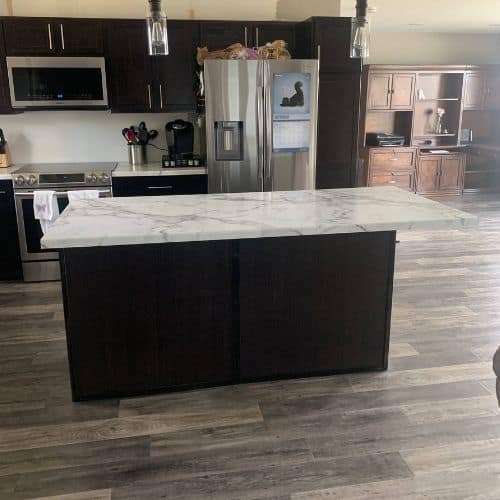
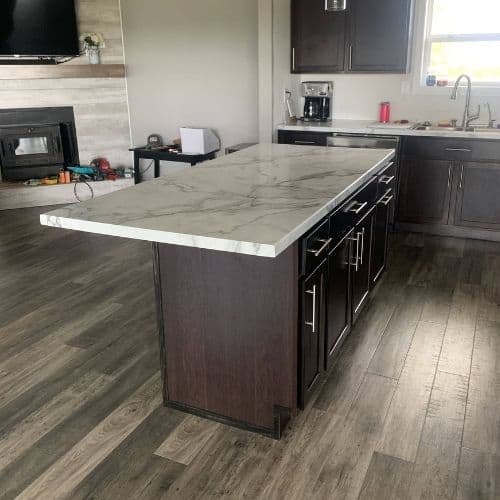
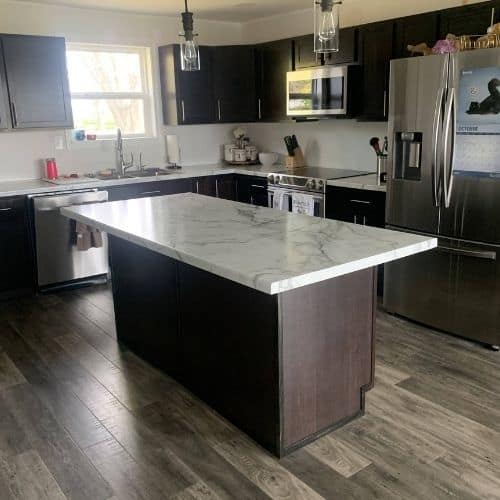

Once you have your beautiful new trim installed, it’s time to install the kitchen handles in less than an hour! Check out my tutorial on how to install perfectly straight kitchen handles every single time.
And once you’re done with the handles, it’s time to style your kitchen island like an interior designer! All you need is a few simple decor pieces to really make a big impact. You can find my full guide to really level up the style of your kitchen island here.
Final Thoughts On How To Finish A Kitchen Island Back Panel
Ta-da! You now have a finished kitchen island back panel! Also, you’ve got a GORGEOUS, CUSTOM-LOOKING kitchen island that you constructed all by yourself AND it only cost you $50!! Hooray for simple kitchen back panel ideas that look awesome!!
Ever since we upgraded our boring, plain kitchen island with this trim, I can’t stop staring at it. I hope you’ll feel the same way about your island as well!
Catch you in my next post!
The Best Kitchen Tools & Products I’ve Used
Ravinte Cabinet Handle Installation Template (For Doors & Drawers)
This is my all-time favorite handle installation template because it has two templates (one for drawers and one for doors) with multiple pull sizes & knob placements! These templates make installing cabinet handles a breeze because you always know your handles will be installed in the same spot on all of your drawers and doors. The kit also comes with a drill bit so you can guarantee you’re using the correct size. I used this template on my entire kitchen and both bathrooms to cut the installation time in half. You can find this hardware template here on Amazon.
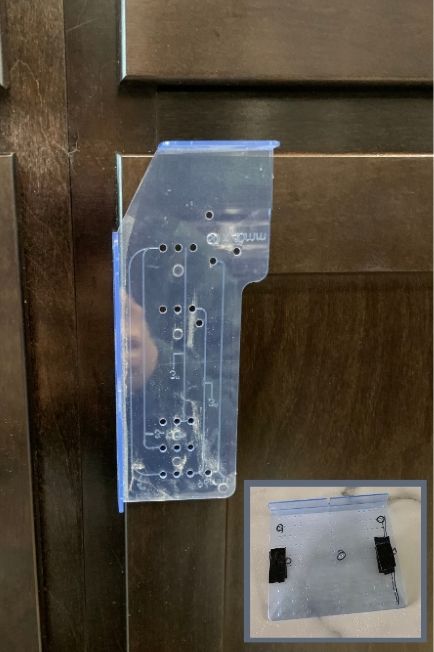
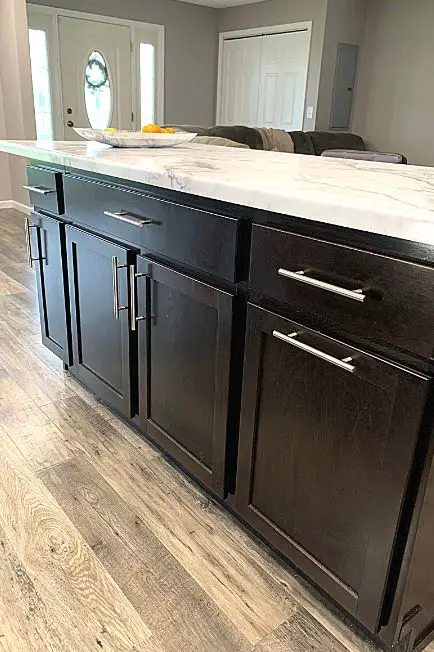
Franklin Brass 5-1/16 Inch (128mm) Center Bar Pull (Stainless Steel)
If you want to immediately modernize your kitchen island, then these cabinet pulls are a must. They are heavy-duty feeling, durable, easy to install, and are a large size for a great price. We put these pulls on all of our kitchen and island doors and drawers along with our bathroom doors and drawers. You can find these gorgeous cabinet pulls here on Amazon.
P.S. Use the hardware installation template I mentioned above to install these new pulls in record time!
If you’ve been curious about how we are decorating our 1950s Ranch, you should check out our “Shop Our Home” page. You can find products that we’ve personally bought to decorate our home.
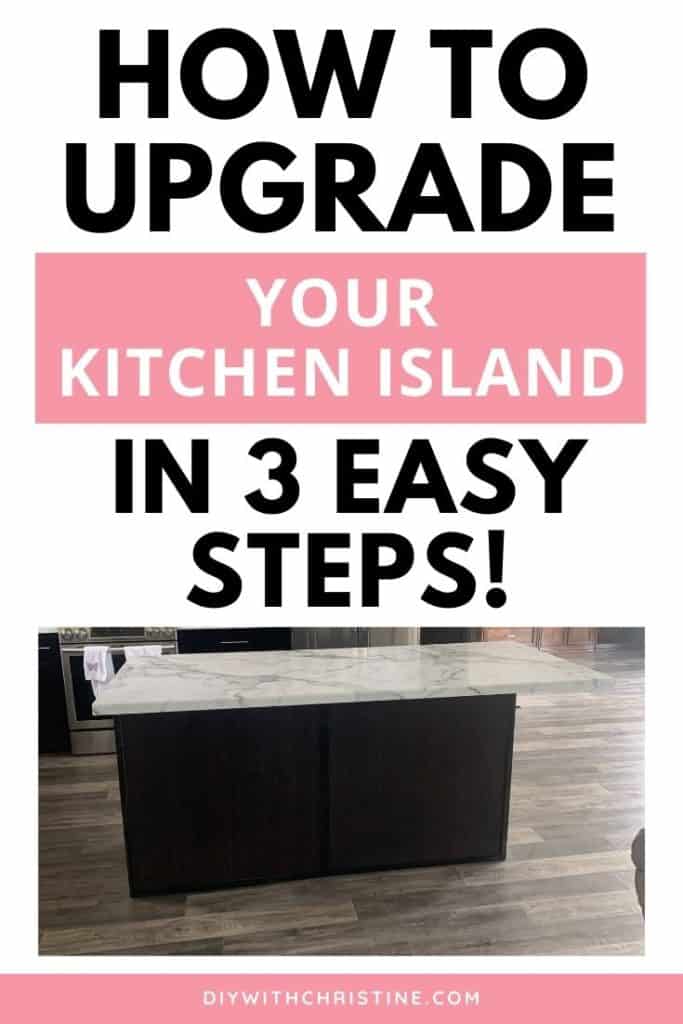

By Christine
Christine is a blogger and DIYer who tackles home renovation and decorating projects alongside her husband, Adam, for their personal residence and rental properties. Although she successfully tackles large renovation projects to avoid expensive contractor fees and bring her vision to life now, her path to success was not easy.
Go here to read her story, “From a Clueless First-Time Homebuyer To A Confident DIYer Creating Her Dream Home One Project At A Time“.
Popular Posts
DIY With Christine is a participant in the Amazon Services LLC Associates Program, an affiliate advertising program designed to provide a means for sites to earn advertising fees by advertising and linking to Amazon.com.


